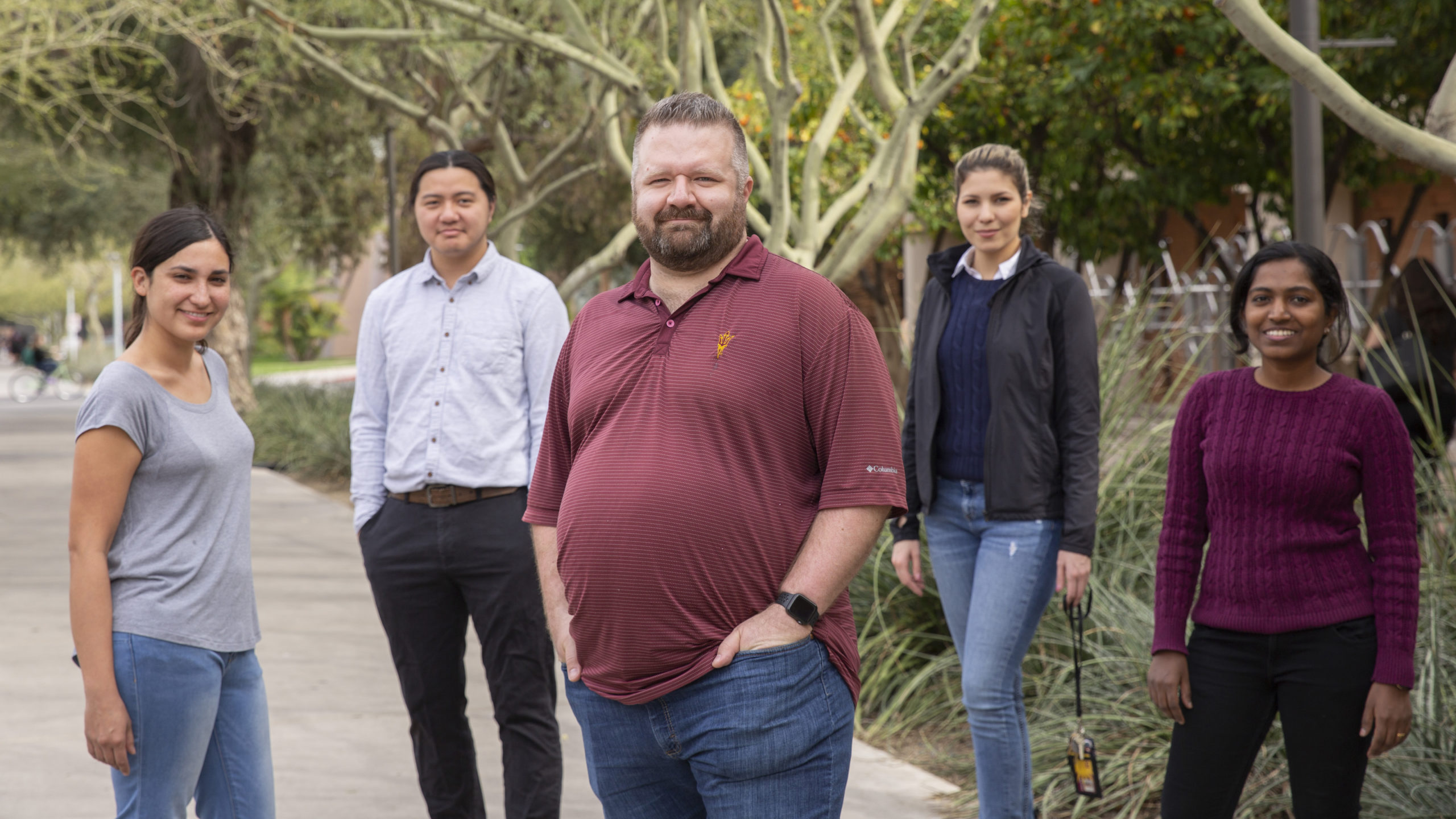
ASU professor builds a student-focused learning environment

Above: Christian Hoover (center), an assistant professor in the Ira A. Fulton Schools of Engineering at Arizona State University, believes that education should be student-focused. His classes on concrete design and structures as well as his National Science Foundation grant-funded research on energy dissipation in glass provide students with an immersive environment to learn about the design process in construction and gain valuable insights into industry experiences. Photographer: Erika Gronek/ ASU
In a world ripe with examples of modern construction, Christian Hoover believes the best learning environment for his concrete design and structures classes is the built environment.
Hoover, an assistant professor of civil and environmental engineering in the School of Sustainable Engineering and the Built Environment, has been teaching in the Ira A. Fulton Schools of Engineering for the past seven semesters. He incorporates the Arizona State University Tempe campus itself in his lectures to break down the barriers between classroom concepts and the real world.
Hoover’s passion for teaching dates back to when he was a student. Growing up, he had several teachers who seemed inaccessible. He uses those experiences as examples of what he doesn’t want to repeat in his own teaching.
“I try to think back upon the things I didn’t like when I was going through school, and I try to improve on them,” Hoover says. “I found myself thinking about this even when I was in primary school and middle school, so I felt like this was my calling.”
Drawing from both the positive and negative experiences in his own education, Hoover has molded his teaching style to be a combination of active learning and collaborative efforts between the instructor and the students, and has adopted a student-focused approach to help his students thrive both in and out of the classroom.
“I really enjoyed experiences when it felt like the teacher was more on an equal level with the students,” Hoover says. “I like to have open conversations with my students, and I like to relate what we’re talking about in the lecture to things that they may be experiencing in their world.”
Drawing from a wealth of industry experience having worked on tall buildings design and inspections with the AXIS Design Group, Hoover urges his students to consider all entities to designing the built environment, such as material costs and sustainability. He shares his experiences with his classes in hopes of preparing them for graduate-level courses or industry work.
Another crucial aspect of the educational experience in Hoover’s classroom is active participation and feedback from his students.
“For the most part, I liked to stick to the traditional lecture format. But ever since coming to ASU, I’ve been more and more exposed to active learning and flipped classroom methodologies, which weren’t really popular when I was in school,” Hoover says. “So, I’ve been incorporating more of these techniques, like ‘think-pair-share,’ where you ask a question and have students pair up and think about the problem.”
Hoover’s goal in all of his classes is to “demystify the role of instructor” and relate to his students by talking about his own experiences. He also connects his course content to examples that can be seen around the ASU campus.
“One of the benefits of ASU is that we have a large collection of healthy examples of construction and engineering happening all around us every day. So, it’s very easy to link what we’re talking about in class to what is being done around campus or even in the surrounding Phoenix area,” Hoover says. “I’ll tell my students, ‘Take a look at ISTB7 [the Interdisciplinary Science and Technology Building 7 currently under construction on ASU’s Tempe campus]. This is what’s happening on campus, and also happens to be what we’re covering in lecture today.’”
Nathan Freeman, a recent civil engineering graduate, is just one student who has been influenced by Hoover’s teaching.
“I was challenged in Dr. Hoover’s steel-reinforced concrete structures class,” Freeman says. “However, that challenge was made easier by Dr. Hoover’s instructional style. He scheduled extra office hours whenever I requested and took an honest interest in any hard-working student who asked for help.”
According to Freeman, Hoover’s teaching philosophy was ultimately student-focused, and this made all the difference to his academic experience.
As a nontraditional student with a family to support, Freeman often found himself unable to begin his assignments until late at night. But when he had questions, Hoover was always there to help and accommodate his needs.
“Dr. Hoover made clear that he is invested in our success,” Freeman says. “There would be times that I would email Dr. Hoover regarding a homework assignment at 10 p.m. on a Sunday, and he would respond at midnight. Sometimes I had to put off my homework until after I could make dinner for my family, do the dishes and get everyone in bed. To have a professor care enough to help me in the wee morning hours is rare.”
Part of Hoover’s teaching philosophy is creating a collaborative environment where both the instructor and the students can contribute to improving the educational experience for both sides.
“Personally, I took issue with the digital organization of the course through Canvas [ASU’s online learning management platform], and I suggested a reorganization of the material online,” Freeman says. “Not only was Dr. Hoover receptive, he executed the changes within one class period.”
Hoover’s students take comfort in knowing they are being heard. When students described having difficulty working problems on their own, he developed a solution to help students follow along with the problems being solved in class.
“It takes an uncommon degree of humility and courage to ask for feedback from the class,” Freeman says, “but it takes passion to go back to your office and make those changes before the next lecture.”
Hoover continues to develop and improve his teaching skills through meetings with The Community of Practice, a monthly meeting where instructors across the School of Sustainability and the Built Environment discuss new teaching techniques and how to incorporate them. Through these meetings and regular meetings with his faculty mentors at ASU, Hoover continues to develop as an instructor, taking advantage of all instructor development resources that the university has to offer.



































